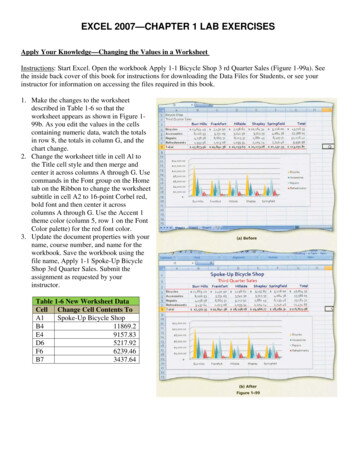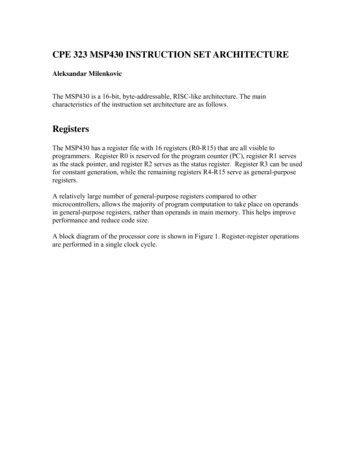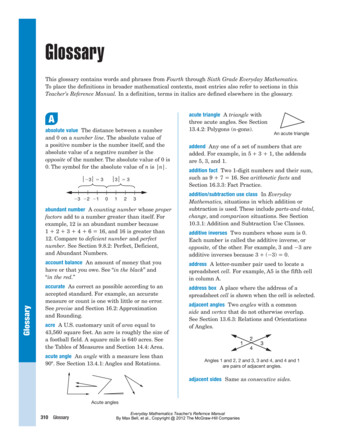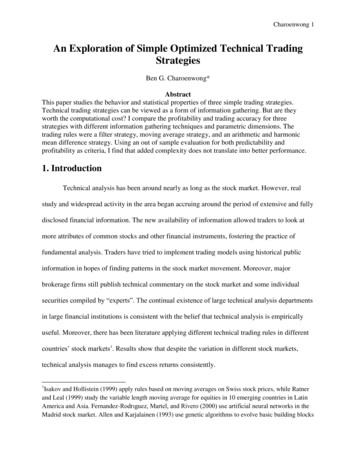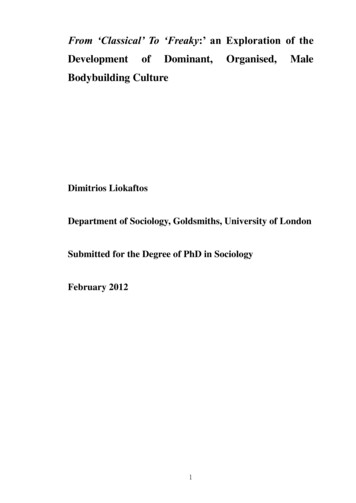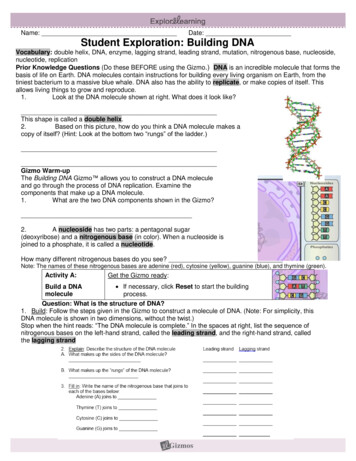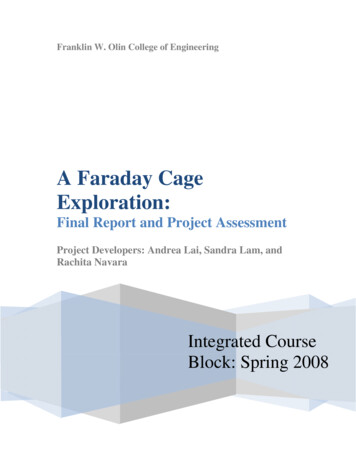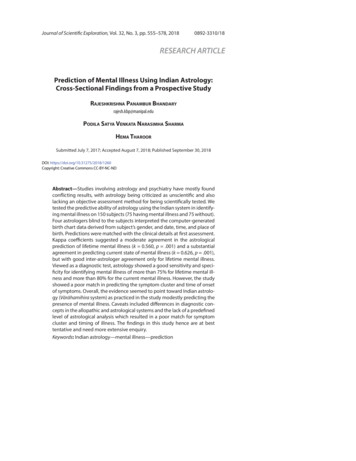
Transcription
Journal of Scientific Exploration, Vol. 32, No. 3, pp. 555–578, 20180892-3310/18RESEARCH ARTICLEPrediction of Mental Illness Using Indian Astrology:Cross-Sectional Findings from a Prospective StudyRAJESHKRISHNA PANAMBUR BHANDARYrajesh.kbp@manipal.eduPODILA SATYA VENKATA NARASIMHA SHARMAHEMA THAROORSubmitted July 7, 2017; Accepted August 7, 2018; Published September 30, 2018DOI: https://doi.org/10.31275/2018/1260Copyright: Creative Commons CC-BY-NC-NDAbstract—Studies involving astrology and psychiatry have mostly foundconflicting results, with astrology being criticized as unscientific and alsolacking an objective assessment method for being scientifically tested. Wetested the predictive ability of astrology using the Indian system in identifying mental illness on 150 subjects (75 having mental illness and 75 without).Four astrologers blind to the subjects interpreted the computer-generatedbirth chart data derived from subject’s gender, and date, time, and place ofbirth. Predictions were matched with the clinical details at first assessment.Kappa coefficients suggested a moderate agreement in the astrologicalprediction of lifetime mental illness (k 0.560, p .001) and a substantialagreement in predicting current state of mental illness (k 0.626, p .001),but with good inter-astrologer agreement only for lifetime mental illness.Viewed as a diagnostic test, astrology showed a good sensitivity and specificity for identifying mental illness of more than 75% for lifetime mental illness and more than 80% for the current mental illness. However, the studyshowed a poor match in predicting the symptom cluster and time of onsetof symptoms. Overall, the evidence seemed to point toward Indian astrology (Vārāhamihira system) as practiced in the study modestly predicting thepresence of mental illness. Caveats included differences in diagnostic concepts in the allopathic and astrological systems and the lack of a predefinedlevel of astrological analysis which resulted in a poor match for symptomcluster and timing of illness. The findings in this study hence are at besttentative and need more extensive enquiry.Keywords: Indian astrology—mental illness—prediction
556R. P. Bh an dar y, P. S . V. N . S h a r m a , a n d H . T h a r o o rIntroductionAstrology has been considered a science in India since the time of the Vedas(ancient Indian texts). For various reasons, astrological sciences have beenreduced to mere assumptions and chance predictions in the modern era.The basis for astrological prediction often appears illogical, unscientific,and indemonstrable in today’s world. However, astrology still persistsbecause it provides a coherent and comprehensive system of thought andgives an explanation for why each human being is different from all others.And astrology provides an explanatory model for the occurrence of illness(Hare 1977). Astrology forms one of the predominant treatment methodsin India during mental illness. A study done in rural India by Kapur (1975)found that 59% of those with mental illness consulted traditional healersand practitioners of indigenous medicines. Out of these, astrology formsa major portion where the chanting of mantras and performing of certainrituals and prayers are a means of therapy. In ancient India, astrology was agood source for health promotion and a guide for preventive, curative, andother aspects of treatment which are mentioned in Ayurvedic (TraditionalIndian Medicine system) literature (Sharma, Prasad, & Narayana 2007,Sharma, Subhatka, & Narayana 2007).Almost all variants of astrology implicate the ill effects of the moonon mental illness. Evidence supports the impact of the lunar cycle on thephysiology of animals and humans, in particular fertility, menstruation,and birth rate (Zimecki 2006). Studies involving epilepsy, which is seenas a mental illness in astrology, have found a clustering of seizures duringthe full moon (Polychronopoulos et al. 2006, Baxendale & Fisher 2008)However, one study by Benbadis et al. (2004) found only pseudoseizuresto have such an association. With regard to lunar cycles and violence,Owen et al. (1998) found a positive correlation among inpatients, andanother study by Hicks-Caskey and Potter (1991) found more misbehaviorin developmentally delayed institutionalized women on days of the fullmoon. Behavioral changes were greater in those with psychotic illnessesas compared with other mental illness during the full moon (Barr 2000).However, Snelson (2004) criticizes these inferences in a study that founda correlation between higher belief scores and the attribution of behavioralchanges in the lunar cycle.Looking at birth charts using the Western astrology system, the CarlsonExperiment did not find a match between people’s acknowledgment ofpersonality profile by psychological assessment and astrologers’ predictions(Carlson 1985). A more recent study by Wyman & Vyse (2008) withNeo Five versus computer-generated astrological profile (as per Westernastrological principles) found more of a chance association. On the other
Predic tion of Men tal I l l n es s U s i n g I n di an A s tr o l o g y557hand, a study by Abdel-Khalek and Lester (2006) who looked at sun signs(Western astrology) found higher anxiety scores in Scorpio, Aquarius,Gemini, Pisces, and Capricorn, and subjects with lowest scores in Libra,Taurus, Leo, and Cancer signs. Natal chart interpretations (analyzingzodiacal signs, interactions among planetary qualities as per Westernastrology, and occurrence of full and new moon dates, on the dates of birth)have also shown some support for key astrological postulates with sunsigns with introversion, and that Mars, a symbol of aggression in outgoingsigns, is more often found in schizophrenics than normal (Ohaeri 1997).Ertel (2009) in his critical appraisal of Carlson’s study had found manydrawbacks regarding the methodology as well as analysis, including the toolused (California Personality Inventory), the analysis done on a piecemealbasis, and small effect sizes for the findings. Also, the author noted that thedesign of the study was unfair as it used a three-choice format over a twochoice format for discrimination.The continuing problem with astrological predictions is that peoplemay tend to associate themselves with profiles that are better than theyare or that make them feel better. Although the practice of astrology isincreasingly seen to be absurd, many believe that this is only because mostof its practitioners are incompetent or fraudulent. This might still be thetruth.The center of this study has the same catchment area as in the studyby Kapur (1975), where health-seeking is through astrologers for mentalillness. Hence, it is of the utmost importance to understand this culturalinfluence while dealing with illness. While studies are restricted to theeffect of the moon (lunar cycle) on suicide (Sharma & Thakur 1980) andemergency admissions (Zargar et al. 2004), no studies seem to have beendone in India on how astrology as a whole concurs with the manifestation ofa psychiatric illness. Hence, it was felt that an investigation into the detectionof mental illness and the prediction of outcomes between the allopathic andastrological systems would be beneficial in helping us to understand the twoperspectives better. Consequently, the present investigation was plannedwhich also attempts to make the assessment a more objective one, usingcomprehensive knowledge of astrology and ensuring adequate blinding ofsubjects from astrologers and vice versa.Brief Introduction to Indian AstrologyMythological claims are that Indian (Vedic/Hindu) astrology originatedfrom Brahma (the creator of the world as per Hinduism) and was broughtto earth by the sages. 18 such works of the sages were then compiled byVārāhamihira in the Fifth Century AD to form the Brihatjataka (Great
558R. P. Bh an dar y, P. S . V. N . S h a r m a , a n d H . T h a r o o rTreatise on Birth History/charts), which forms the major source of referencefor interpretation in Indian astrology.The foundations for predictions about an individual lie in the plottingof the birth chart. The zodiac is an imaginary belt in the sky in which theplanets travel. The zodiac is divided into 12 equal parts of 30 each whichform the Rashi (or the zodiac sign). According to this system, there are 9planets that have influence on the earth (and are identifiable from the earth).In addition to the 5 planets up to Saturn, the Sun and Moon are also taken asplanets. In addition, there are two imaginary nodal points (at 180 from eachother) called Rahu and Ketu, which are referred to as the shadow planets.The Zodiac is also divided into 27 constellations of 13 20 each based onthe position of the star, and each constellation is further subdivided into 4quarters. The planets are plotted in reference to their position in the zodiacwith reference to the position of the birth star as viewed from earth (hencethis system is called sidereal). The time of birth determines the zodiac signfor the individual which can change within a day based on the position of theSun. Depending on the need, the birth chart can have accessory charts thatplot the planets into smaller divisions within the Zodiac, in order to reacha higher accuracy. Planets are assigned strengths based on the constellationthey are in, the relative position from the zodiac sign, as well as based onthe position of other planets in the Zodiac. While this forms the static chartat birth, the dynamic component is analyzed by the operational periods ofthe planets (which varies from 6 years to 20 years) across a timeframe of120 years. Each operational period can be further divided into smaller suboperational periods based on the same ratio to reach timeframes of months,weeks, days, hours, minutes, and even seconds as per the level of accuracyrequired. Alternatively, prediction for the day can be given based on theplanetary position for that day compared with the position in the birth chart.The Indian (Vedic/Hindu) and Western astrologies differ in variousaspects of interpretation. Indian astrology uses zodiac signs based on theposition of the birth star and the moon’s transit, as compared with the sun’stransit which is the concept followed in Western astrology. Each house inthe birth chart has its role in interpretation, irrespective of whether it housesa planet. Movement of the planets across the Zodiac as well as planetaryand sub-planetary periods are used in interpretation rather than just usingtransit, in Indian astrology. And the interpretation involves a complexinterplay between planets within the house, opposite houses, the rulingplanet of the house, as well as the birth star, the current position of theplanets, their strengths and weaknesses, and some of the supplementary birthcharts (which assess the influence of familial factors, effects of residence,education, spirituality, wealth, etc.) are looked into for prediction. Thereby,
Predic tion of Men tal I l l n es s U s i n g I n di an A s tr o l o g y559this system is comprehensive and sophisticated (Sethi 2007).There are many other systems of astrology such as Chinese, Mayan,Celtic, Babylonian, etc., which have their own interpretative methods.Debate exists about which of these entities originated first and whichlater and which was the parent, but one of the critical reviewers of Vedicastrology opines that some elements of Mesopotamian, Greco-Babylonian,and Greco-Egyptian systems were incorporated into the Indian systemaround the 5th century when Vārāhamihira composed the treatise (Koch2012/2013). Mayan astrology has a system base of 20, with 20 zodiac signs,one for each day with the cycle repeating every 20 days, 4 determinantsbased on direction, as well as a second personality zodiac (20 in number)which changes every 13 days in a 260-day calendar. A ruler god / lord ofthe night for every 9 days and a 52-year cycle indicate a complex method ofinterpretation, like Vedic astrology (Astrology of the Ancients 2012–2017).The Chinese system on the other hand follows a 60-year cycle with 12zodiacs represented by animals and 5 elements (air, water, fire, wood, andmetal). The day is divided into 12 time periods representing each zodiacanimal’s prominence. The time and events / omens around the time of birthare used for predictions (Astrosage 2013). Key characteristics of differentastrological systems are mentioned in a brief blog article by Segurelha(2008).Prediction of Mental Illness Using Indian AstrologyPrediction in Indian astrology involves interplay between variouscomponents of the birth chart as well as the planetary movements acrossthe Zodiac. To understand the concept in a simplified way, the birth chartindicates some degree of susceptibility for the illness, while the planetarymovements and periods indicate the likelihood of its expression during thetime period. With regard to prediction of mental illnesses, the positions ofmoon, Saturn, and the shadow planets Rahu–Ketu play a major role. Theruling planets of the houses, the supporting and opposing nature of planets,their original position at birth, all are taken into consideration while makinga prediction. The system also involves a minimum knowledge of Ayurvedafor use of terminologies in predicting health and illness. A fair outline aboutprinciples used in predicting mental illness can be read in the articles byTantri (2007) and Chauhan (2014).Variants within Indian AstrologyAstrology is not practiced in the same way by all followers of the Indiansystem. While basic steps in interpretation remain the same, there are
560R. P. Bh an dar y, P. S . V. N . S h a r m a , a n d H . T h a r o o rtwo other versions of plotting birth charts that are in vogue. The LalKitaab uses a fixed-house system no matter where the ascendant is. Theinterpretation guidelines are modified accordingly to suit simpler analysisand to recommend simple remedies for problems. This came from amixture
The Indian (Vedic/Hindu) and Western astrologies differ in various aspects of interpretation. Indian astrology uses zodiac signs based on the position of the birth star and the moon’s transit, as compared with the sun’s transit which is the concept followed in Western astrology. Each house in the birth chart has its role in interpretation, irrespective of whether it houses a planet .
